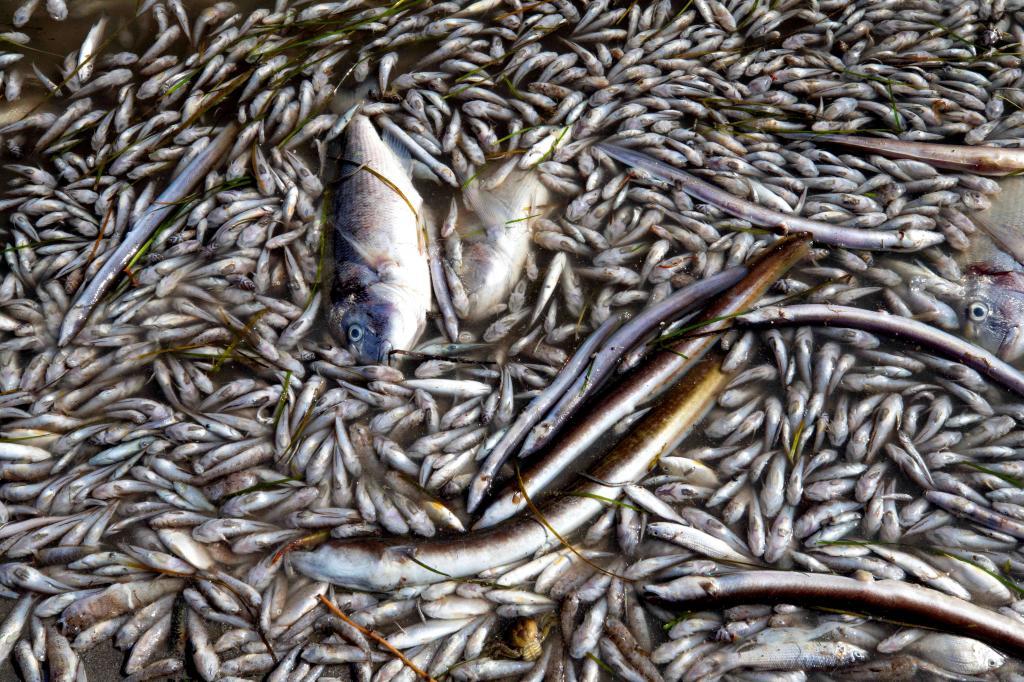- Cold drop.The Prosecutor's Office will investigate the discovery of thousands of dead fish and crustaceans in the Mar Menor
- Mar Menor. From Mediterranean paradise to animal cemetery
A scientific study blames the situation of the Mar Menor crisis on the large amounts of organic matter and nutrients that the lagoon has received since the 1980s from spills of diverse nature, and states that the effect of torrential rains caused by the Isolated Depression In High Levels (DANA) it is not explained without taking into account the whole degradation process suffered for years.
This is reflected in a study prepared by scientists from the Spanish Institute of Oceanography (IEO), the University of Alicante, the Polytechnic University of Cartagena and the New Water Culture Foundation.
Regarding the causes of the Mar Menor crisis, this report highlights that since the 1980s, the lagoon has received large quantities of organic matter and nutrients from spills of diverse nature, including urban wastewater (currently practically suppressed, except for episodes of rainfall and point discharges) and, above all, the diffuse and punctual pollutant flows, coming from the agricultural and agricultural activity of the Campo de Cartagena.
"From four meters deep, everything died in the Mar Menor after DANA because it ran out of oxygen," according to IEO sources consulted by Europa Press, which explain that very high extensions of the deep waters of the lagoon They ran out of oxygen. "It is not something local, registered in Villananitos," they say.
According to IEO sources consulted by Europa Press, the effects of DANA cannot be explained if the entire degradation process that the Mar Menor has suffered due to nutrient inflows into the lagoon for decades and the transformation is not taken into account which has had the entire drainage basin that represents the Campo de Cartagena.
This is reflected in the 'Synthesis Report on the current state of the Mar Menor and its causes in relation to nutrient contents', which highlights that, for decades, the contributions of nutrients (mainly nitrates, but also phosphate and ammonium) and Organic matter to the Mar Menor has forced the change of the system, originally oligotrophic, to a eutrophic state.
This state "defines an enrichment in inorganic nutrients (nitrogen and phosphorus) beyond the critical level of the self - regulating capacity of a given system."
After the DANA last September, the report highlights that the water carried from the rain mixed with the surface layer of water in the lagoon and chlorophyll levels increased sharply to levels higher than the maximum of 2016, what has been attributed to the massive entry of nitrogen, phosphorus and organic matter associated with the entry of water, terrific sediments and entrained materials from the Cartagena Field.
The deep water layer (characterized by the conditions of salinity and phytoplankton load of the lagoon water prior to the DANA) was isolated. The water column was stratified, forming a less saline surface layer , reducing atmospheric oxygen transfer to deeper parts of the water column.
Lack of light in the background, key
In parallel, the high turbidity of the water drastically reduced the light reaching the bottom, preventing the production of oxygen by the photosynthetic activity of the benthic vegetation. In the deep water layer from three meters deep, oxygen was depleted as a result of the decomposition of the organic matter present (both existing and introduced during floods).
"The black color of the water and the smell of hydrogen sulfide emanating from the lagoon were clear indicators of the existence of a strong anaerobic sulfate-reducing metabolism in the deep anoxic layer," according to the report, which highlights that "one of the consequences of this metabolism is the appearance of sulfides dissolved in water, which are toxic to many animals and plants. "
"The combination of absence of oxygen and presence of sulphides in the deep water layer caused the death of life associated with the lagoon bottom and the massive flight of organisms of all species with displacement capacity , towards the shallowest areas of the lagoon "he underlines.
This report estimated that an area exceeding 9,000 hectares had again been devastated at the bottom of the lagoon.
This is a report signed by Juan Manuel Ruiz Fernández , from the Spanish Institute of Oceanography; Víctor M. León of the Spanish Institute of Oceanography; Lázaro Marín Guirao of the Spanish Institute of Oceanography; Francisca Giménez Casalduero of the University of Alicante; José Alvárez Rogel of the Polytechnic University of Cartagena; Miguel Angel Esteve Selma of the University of Murcia; Rosa Gómez Cerezo of the University of Murcia; Francisco Robledano Aymerich of the University of Murcia; Gonzalo González Barberá of CEBAS-CSIC; and Julia Martínez Fernández of the New Water Culture Foundation.
According to the criteria of The Trust Project
Know more
